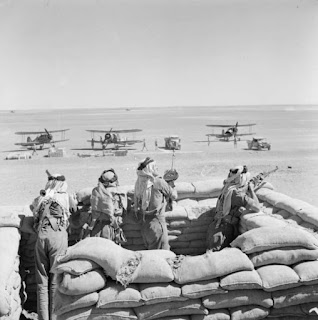Although fully occupied in confronting the Germans and Italians in Africa and the Balkans during the spring and summer of 1941
Although fully occupied in confronting the Germans and Italians in Africa and the Balkans during the spring and summer of 1941, Britain’s Middle East Command soon found itself embroiled in three peripheral campaigns within the region.
The first of these related to the Kingdom of Iraq, which was created after the First World War with the breakup of the Ottoman Empire. In 1920 Iraq became a British mandate. Ten years later the two parties signed a treaty granting Iraq independence in 1932.
As part of this treaty, Britain retained the right to transit troops through the newly independent nation. Likewise, Iraq was required to maintain internal security for its vital oil infrastructure and to provide the British with all aid, including the use of railways, rivers, ports and airfields, in the event of war.
Finally, the British were allowed to maintain two RAF bases within the country. One of these was at Shaibah near Basra, while the other was at Habbaniya about 55 miles west of Baghdad on the Euphrates. In 1941 both bases were used as communication and training centres and thus lacked front-line aircraft.
Yet, despite their limited resources, both bases were considered important staging posts on the route between Egypt and India.
In April 1941 a pro-Axis government under the leadership of Prime Minister Rashid Ali al Gailani came to power in Iraq as the result of a military coup.
Alarmed by the threat this action posed to their vital oil supplies within the theatre as well as other logistical and political consequences, the British landed the 20th Indian Infantry Brigade, a Royal Artillery field regiment and the headquarters of the 10th Indian Division at Basra on 18 April. Eight merchant ships under the protection of the sloops Yarra, Falmouth and Lawrence facilitated this move.
Further warships, including the aircraft carrier Hermes and the cruisers Emerald, Leander and Enterprise, also proceeded into the area to strengthen the British position. In the days and weeks that followed the British landed additional forces at Basra and flew military and aircraft reinforcements into their base at Habbaniya.
While these actions were arguably permissible under Britain’s treaty rights, the new Iraqi government responded by sending strong military forces to envelop the British base at Habbaniya. By 1 May these encircling forces numbered some 9,000 men and 50 guns. The British responded to this provocation by seizing control of the airport, docks and power station at Basra and demanding the withdrawal of Iraqi forces from Basra and the areas surrounding Habbaniya.
When the Iraqis refused to withdraw their forces, the British launched a pre-emptive campaign on 2 May to remedy the situation. Utilizing various training and support aircraft that had been converted for offensive use as well as a handful of recently arrived Wellington and Blenheim bombers, the British launched a series of strikes against their besiegers.
This began a period of general hostilities. In this, the British were able to use their relative superiority in the air to keep the Iraqis at bay around Habbaniya while their ground forces consolidated control over Basra. FAA Swordfish from Hermes supported these operations, and within a week the British had largely neutralized the small Iraqi air force having destroyed some 30 aircraft with many more damaged.
The Iraqis responded to this onslaught by issuing urgent requests for Axis assistance. These requests prompted the Germans and, to a lesser extent, the Italians to send a few dozen aircraft to support their new Iraqi allies. Using Vichy-controlled Syria as a staging base, German aircraft first appeared over Iraq on 11 May, but these aircraft were too few in numbers and too poorly supported to have much of an impact on the campaign.
Likewise, these appearances quickly incited the RAF to carry out a number of bombing raids against the main Syrian airfields at Aleppo, Damascus, Rayak and Palmyra thus further disrupting the effectiveness of the small Luftwaffe contingent.
Meanwhile, on 11 May a 5,800-strong British relief column, designated ‘Habforce’, departed Palestine and proceeded eastward into Iraq. On the 18th the spearhead of this force, designated ‘Kingcol’, reached Habbaniya thus formally lifting the siege. From there, the British pressed forward towards the Iraqi capital of Baghdad.
During the next twelve days the British fought a series of intermediate actions before finally reaching the capital outskirts on the 30th. On the same day, Rashid Ali al Gailani and his close supporters fled Baghdad and sought refuge in neighbouring Iran. A few hours later the Lord Mayor of Baghdad petitioned the British for an armistice, which was agreed upon going into effect on the 31st. With this, the fighting in Iraq ceased, and the situation was restored to Britain’s satisfaction. British military casualties for the brief campaign numbered about 100 while the RAF lost 34 killed, 64 wounded and 28 aircraft destroyed.
Iraqi personnel casualties amounted to 497 dead, 686 wounded, 548 missing and over 1,000 prisoners taken. Likewise, the small Iraqi air force, which numbered over 50 aircraft, was all but destroyed while the Luftwaffe lost five bombers and 14 fighters and the Regia Aeronautica another three fighters in operations related to Iraq.
Pictured here are Arab Legionnaires guarding a landing ground in Transjordan as Gloster Gladiators of No. 94 Squadron RAF refuel during their journey to reinforce the besieged garrison at Habbaniya on 8 May 1941.
H Hensser, Royal Air Force official photographer, Public Domain. Also pictured are British troops in Baghdad in June 1941. No 1 Army Film & Photographic Unit, Tanner A R (Lieut), Public Domain. For more information on this and other related topics, see Blue Water War, the Maritime Struggle in the Mediterranean and Middle East, 1940-1945.












Comments
Post a Comment